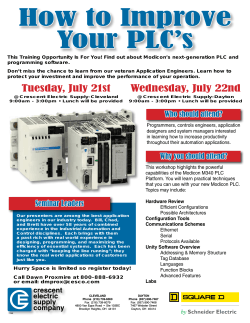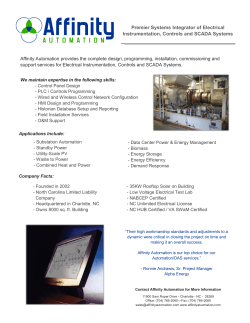
âINDUSTRIAL DRIVES & AUTOMATION USING PLCâ Abstract
“INDUSTRIAL DRIVES & AUTOMATION USING PLC”
Bhagyashree Nagarkar
EX-5 sem, All Saints’ College of Technology,Bhopal
e-mail:- bhagyashreenagarkar@rocketmail.com
th
Abstract
Introduction
Automation devices such as controllers
and data systems and/or services.
Systems and methods are provided that
receive statements or other unit of data
interaction from an automation device,
provide the statements to an appropriate
system or service for processing, and
optionally return a response such as a
result set. Furthermore, in accordance
with an aspect of the invention native
controller code, variables, or tags can be
mapped to stored data, procedures or
combinations of data and/or procedures
and updated automatically or semiautomatically. A programmable logic
controller (PLC) or programmable
controller is a digital computer used for
automation
of
electromechanical
processes, such as control of machinery
on factory assembly lines, amusement
rides, or lighting fixtures. PLCs are used
in many industries and machines. Unlike
general-purpose The subject invention
pertains to facilitating communication
between industrial computers, the PLC is
designed for multiple inputs and output
arrangements, extended temperature
ranges, immunity to electrical noise, and
resistance to vibration and impact.
Programs to control machine operation
are typically stored in battery-backed or
non-volatile memory. A PLC is an
example of a real time system since
output results must be produced in
response to input conditions within a
bounded time, otherwise unintended
operation will result.
Automation is the use of control systems
(such
as
numerical
control,
programmable logic control, and other
industrial control systems), in concert
with other applications of information
technology (such as computer-aided
technologies [CAD, CAM, CAx]), to
control industrial machinery and
processes, reducing the need for human
intervention.
In
the
scope
of
industrialization, automation is a step
beyond
mechanization.
Whereas
mechanization
provided
human
operators with machinery to assist them
with the muscular requirements of work,
automation greatly reduces the need for
human sensory and mental requirements
as well. Processes and systems can also
be automated.Automation plays an
increasingly important role in the global
economy and in daily experience.
Engineers strive to combine automated
devices
with
mathematical
and
organizational tools to create complex
systems for a rapidly expanding range of
applications and human activities. Many
roles for humans in industrial processes
presently lie beyond the scope of
automation.
Human-level
pattern
recognition, language recognition, and
language production ability are well
beyond the capabilities of modern
mechanical and computer systems.
Tasks requiring subjective assessment or
synthesis of complex sensory data, such
as scents and sounds, as well as highlevel tasks such as strategic planning,
currently require human expertise. In
many cases, the use of humans is more
cost-effective
than
mechanical
approaches even where automation of
industrial tasks is possible.Specialised
hardened computers, referred to as
programmable logic controllers (PLCs),
are frequently used to synchronize the
flow of inputs from (physical) sensors
and events with the flow of outputs to
actuators and events. This leads to
precisely controlled actions that permit a
tight control of almost any industrial
process.
cylinders, magnetic relays, solenoids, or
analog outputs. The input/output
arrangements may be built into a simple
PLC, or the PLC may have external I/O
modules attached to a computer network
that plugs into the PLC
Architecture of PLCs
History
The PLC was invented in response to the
needs of the American automotive
manufacturing industry. In 1968 GM
Hydramatic (the automatic transmission
division of General Motors) issued a
request for proposal for an electronic
replacement for hard-wired relay
systems. The first PLC, designated the
084 because it was Bedford Associates'
eighty-fourth project, was the result.
Dick Morley, who is considered to be
the "father" of the PLC.
Features of PLC
The main difference from other
computers is that PLCs are armored for
severe conditions (such as dust,
moisture, heat, cold) and have the
facility for extensive input/output (I/O)
arrangements. These connect the PLC to
sensors and actuators. PLCs read limit
switches, analog process variables (such
as temperature and pressure), and the
positions of complex positioning
systems. Some use machine vision. On
the actuator side, PLCs operate electric
motors,
pneumatic
or
hydraulic
Developments in PLC
Early PLCs were designed to replace
relay logic systems. These PLCs were
programmed in "ladder logic", which
strongly resembles a schematic diagram
of relay logic. This program notation
was chosen to reduce training demands
for the existing technicians. Other early
PLCs used a form of instruction list
programming, based on a stack-based
logic solver.
Modern PLCs can be programmed in a
variety of ways, from ladder logic to
more traditional programming languages
such as BASIC and C. Another method
is State Logic, a very high-level
programming language designed to
program PLCs based on state transition
diagrams.
Programming in PLC
Early PLCs, up to the mid-1980s, were
programmed
using
proprietary
programming panels or special-purpose
programming terminals, which often had
dedicated function keys representing the
various logical elements of PLC
programs. Programs were stored on
cassette tape cartridges. Facilities for
printing and documentation were very
minimal due to lack of memory capacity.
The very oldest PLCs used non-volatile
magnetic core memory.
SCADA
The term SCADA usually refers to
centralized systems which monitor and
control entire sites, or complexes of
systems spread out over large areas
(anything between an industrial plant
and a country). Most control actions are
performed automatically by Remote
Terminal Units ("RTUs") or by
Programmable
Logic
Controllers
("PLCs"). Host control functions are
usually restricted to basic overriding or
supervisory level intervention. For
example, a PLC may control the flow of
cooling water through part of an
industrial process, but the SCADA
system may allow operators to change
the set points for the flow, and enable
alarm conditions, such as loss of flow
and high temperature, to be displayed
and recorded. The feedback control loop
passes through the RTU or PLC, while
the SCADA system monitors the overall
performance of the loop.
Data acquisition begins at the RTU or
PLC level and includes meter readings
and equipment status reports that are
communicated to SCADA as required.
Data is then compiled and formatted in
such a way that a control room operator
using the HMI can make supervisory
decisions to adjust or override normal
RTU (PLC) controls. Data may also be
fed to a Historian, often built on a
commodity
Database
Management
System, to allow trending and other
analytical auditing.SCADA systems
typically implement a distributed
database, commonly referred to as a tag
database, which contains data elements
called tags or points. A point represents
a single input or output value monitored
or controlled by the system. Points can
be either "hard" or "soft". A hard point
represents an actual input or output
within the system, while a soft point
results from logic and math operations
applied to other points. (Most
implementations conceptually remove
the distinction by making every property
a "soft" point expression, which may, in
the simplest case, equal a single hard
point.) Points are normally stored as
value-timestamp pairs: a value, and the
timestamp when it was recorded or
calculated. A series of value-timestamp
pairs gives the history of that point. It's
also common to store additional
metadata with tags, such as the path to a
field device or PLC register, design time
comments, and alarm information.
of a pump connected to a pipe can show
the operator that the pump is running
and how much fluid it is pumping
through the pipe at the moment. The
operator can then switch the pump off.
The HMI software will show the flow
rate of the fluid in the pipe decrease in
real time. Mimic diagrams may consist
of line graphics and schematic symbols
to represent process elements, or may
consist of digital photographs of the
process equipment overlain with
animated symbols.
Human Machine Interface
The HMI package for the SCADA
system typically includes a drawing
program that the operators or system
maintenance personnel use to change the
way these points are represented in the
interface. These representations can be
as simple as an on-screen traffic light,
which represents the state of an actual
traffic light in the field, or as complex as
A Human-Machine Interface or HMI is
the apparatus which presents process
data to a human operator, and through
which the human operator controls the
process.
An HMI is usually linked to the SCADA
system's
databases and software
programs,
to
provide
trending,
diagnostic data, and management
information
such
as
scheduled
maintenance
procedures,
logistic
information, detailed schematics for a
particular sensor or machine, and expertsystem troubleshooting guides. This
means that the operator can see a
schematic representation of the plant
being controlled. For example, a picture
a multi-projector display representing
the position of all of the elevators in a
skyscraper or all of the trains on a
railway.
An important part of most SCADA
implementations are alarms. An alarm is
a digital status point that has either the
value NORMAL or ALARM. Alarms
can be created in such a way that when
their requirements are met, they are
activated. An example of an alarm is the
"fuel tank empty" light in a car. The
SCADA operator's attention is drawn to
the part of the system requiring attention
by the alarm. Emails and text messages
are often sent along with an alarm
activation alerting managers along with
the SCADA operator.
The main disadvantages of automation
are:
Advantages
The main advantage of automation are:
Replacing human operators in
tedious tasks.
Replacing humans in tasks that
should be done in dangerous
environments (i.e. fire, space,
volcanoes, nuclear facilities,
under the water, etc)
Making tasks that are beyond the
human capabilities such as
handling too heavy loads, too
large objects, too hot or too cold
substances or the requirement to
make things too fast or too slow.
Economy
improvement.
Sometimes and some kinds of
automation implies improves in
economy of enterprises, society
or most of humankind. For
example, when an enterprise that
has invested in automation
technology
recovers
its
investment; when a state or
country increases its income due
to automation like Germany or
Japan in the 20th Century or
when the humankind can use the
internet which in turn use
satellites and other automated
engines.
Disadvantages
Technology
limits.
Current
technology is unable to automate
all the desired tasks.
Unpredictable
development
costs.
The
research
and
development cost of automating
a process is difficult to predict
accurately beforehand. Since this
cost can have a large impact on
profitability, it's possible to finish
automating a process only to
discover that there's no economic
advantage in doing so.
Initial costs are relatively high.
The automation of a new product
required a huge initial investment
in comparison with the unit cost
of the product, although the cost
of automation is spread in many
product batches. The automation
of a plant required a great initial
investment too, although this cost
is spread in the products to be
produced.
Applications
1. PLCs may need to interact with
people for the purpose of configuration,
alarm reporting or everyday control.
2. Most modern PLCs can communicate
over a network to some other system,
such as a computer running a SCADA
(Supervisory
Control
And
Data
Acquisition) system or web browser.
3.Use of PLC in storing watera facility needs to store water in a tank.
The water is drawn from the tank by
another system, as needed, and our
example system must manage the water
level in the tank.
Using only digital signals, the PLC has
two digital inputs from float switches
(Low Level and High Level). When the
water level is above the switch it closes a
contact and passes a signal to an input.
The PLC uses a digital output to open
and close the inlet valve into the tank.
When the water level drops enough so
that the Low Level float switch is off
(down), the PLC will open the valve to
let more water in. Once the water level
rises enough so that the High Level
switch is on (up), the PLC will shut the
inlet to stop the water from overflowing.
This rung is an example of seal in logic.
The output is sealed in until some
condition breaks the circuit.
|
|
|
Low Level
High Level
Fill Valve
|
|------[/]------|------[/]---------------------(OUT)---------|
|
|
|
|
|
|
|
|
|
|
Fill
Valve
|
|
|------[
]------|
|
|
|
|
An analog system might use a water
pressure sensor or a load cell, and an
adjustable (throttling) dripping out of the
tank, the valve adjusts to slowly drip
water back into the tank.In this system,
to avoid 'flutter' adjustments that can
wear out the valve, many PLCs
incorporate
"hysteresis"
which
essentially creates a "deadband" of
activity. A technician adjusts this
deadband so the valve moves only for a
significant change in rate. This will in
turn minimize the motion of the valve,
and reduce its wear.A real system might
combine both approaches, using float
switches and simple valves to prevent
spills, and a rate sensor and rate valve to
optimize refill rates and prevent water
hammer. Backup and maintenance
methods can make a real system very
complicated .
Conclusions
A PAC provides in a single compact
controller the advanced control features,
network
connectivity,
device
interoperability, and enterprise data
integration capabilities found in PLC- or
PC-based automation controllers. With
these features, the PAC has become an
integral part ofmeeting the new and
diverse requirements demanded in a
modern industrial application.
Reference
http://www.plcs.net/chapters/hist
ory2.htm
http://www.koldwater.com/down
loadform.htm
http://www.htservices.com/Tutor
ials/plctutorial1.htm
http://www.sea.siemens.com/step
/templates/lesson.mason?plcs:1:1
:1
http://www.thelearningpit.com/ps
im/psim.html
© Copyright 2025









